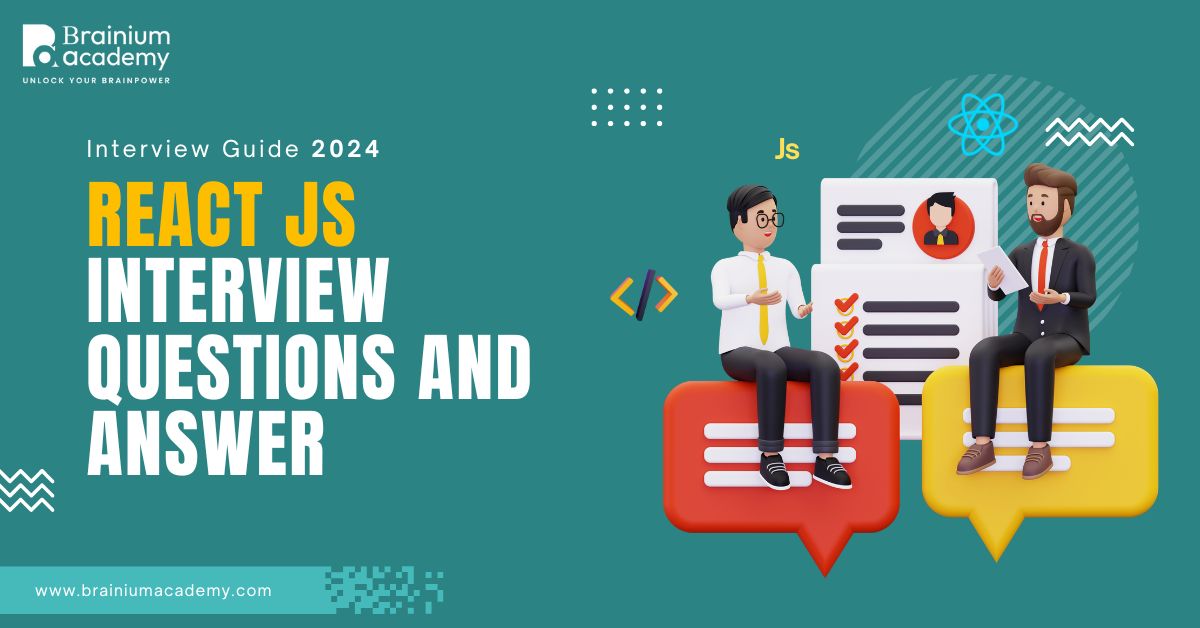
Interview Guide 2024: React JS Interview Questions and Answers
React is a popular JavaScript-based library and is commonly used in web development. It is extremely versatile and offers tons of possibilities to address diverse development requirements. The fact that it can be used to craft custom components and enables the creation of varied functionalities to heighten the user experience, is what makes it a tad unique. All this has led to a surge in demand for developers adept at React JS. If you are one of them and are actively looking to score a job, these React JS interview questions and answers that we’ve discussed below, are just for you.
One of the biggest challenges that most businesses face is the need for responsive and scalable web apps and that is where React comes in. In fact, this JavaScript library developed by Facebook, has fast become one of the most widely used frameworks to craft modern web applications. According to Statista, around 40.58% of respondents claim to use it. This is why companies need young professionals with knowledge in React.
Tricky React interview questions for freshers and experienced
Whether you’re a seasoned developer looking to level up or a newcomer eager to make your mark, our exhaustive compilation of React JS interview questions is your ticket to securing a coveted position in a top-tier company. So, without any delay, let’s dive in.
1: Mention some of the features of React.JS?
The fact that React makes use of a virtual DOM instead of a real DOM, offers server-side rendering for complete HTML file rendering, and a unidirectional data flow is what makes React special. Such features streamline development, heighten performance, and allow developers to come up with robust web applications.
2: What is JSX?
The term JSX stands for JavaScript XML. It is an elegant syntax extension of JavaScript within React based on ES6, that simplifies crafting visually stunning user interfaces. It gets translated to regular JavaScript at runtime. Developers harness its power to effortlessly articulate UI designs. To put it simply, JSX is used to write the HTML structures.
3: What are some of the limitations of React?
React, while powerful, has its own limitations. It is not a comprehensive framework but instead a library. Also, its numerous components can be overwhelming for beginners, and grasping it takes time. Thus, understanding React may be a bit challenging for novice programmers. Moreover, the coding can get quite complex due to the use of inline templating and JSX. Despite these limitations, mastering React opens doors to building dynamic and efficient web applications.
4: What are props in React?
Props in React is a special keyword that stands for properties, and is used for passing data between components as parameters. So, its working functionality is quite like HTML attributes. Data with props pass in a unidirectional flow – from parent to child. Websites built with React, such as Twitter (Now called X), Netflix, and even Facebook, use the same design patterns across sections but have different data. This is achieved by using props.
5: What is the basic difference between Element and Component?
Element is a blueprint of what you want the screen to show in terms of DOM nodes and other components. Elements are designed to contain other Elements in their props, if needed. But once an Element is created, it can’t be mutated. On the other hand, a Component is much more versatile. It can either be declared as a class or can be defined as a function. In both the case, it takes props as input and returns a JSX tree as the final output.
6: What is the state in React?
This is one of the most basic React JS interview questions for freshers. The state is a built-in React object that contains data about the component. A component’s state can change as a response to any user action or due to system-generated events. However, whenever it changes, the component re-renders.
7: What is the difference between props and state?
Both state and props are simple JavaScript objects used to manage the data of any component, but they have different characteristics and are used in different ways. The state is used to manage the component and the latter can modify the state. Any changes in the state triggers a re-render of the component. As for props, these are read-only, so they cannot be modified by its own component. They are used to configure the behavior of components and pass data between components.
8: What is Virtual DOM?
Virtual DOM, also known as VDOM, is an in-memory representation of the actual or Real DOM. It has the same properties as the Real DOM, but lacks the power to influence what’s on the screen. In React, manipulating the DOM can be painstakingly slow, but manipulating the VDOM is a faster process. In simple words, manipulating the virtual DOM can be best compared to altering the blueprint of a house, as opposed to moving the actual rooms of the house.
9: What is the difference between Virtual DOM and Shadow DOM?
A Shadow ROM is used to craft component-based apps and websites. It is not a complete representation of the Real DOM and instead acts as a subtree, or more of a separate DOM for specific elements. The Shadow DOM is basically a browser technology primarily used for scoping variables and CSS. On the other hand, Virtual DOM is a complete representation of the actual DOM. Since changes to the DOM can cause the page to re-render every time, VDOM avoids unnecessary hassle and time-taking changes to the DOM. This is achieved by clubbing all small changes together and doing a single re-render, instead of multiple small ones.
10: What is Redux?
Redux is an open-source JavaScript library that is basically used to manage application state. React developers use Redux to build any user interface. It was introduced by Andrew Clark and Dan Abramov back in 2015 and is now widely used. It was supposedly inspired from Flux, but omitted the unnecessary complexities of Flux. It would be wise to add that React Redux is the official React binding for Redux, thereby allowing components to read data from the Redux store.
11: What is reconciliation in React?
React’s reconciliation is the process through which React.JS updates its browser DOM. When the state of a component changes, it is up to React to determine the updates needed by the DOM. This is where reconciliation comes in. Reconciliation updates the VDOM first and then uses the diffing algorithm to make necessary changes to the actual DOM. React’s reconciliation process/ algorithm is thus a complex piece of engineering that brings in a blend of speed and simplicity.
12: What are stateful and stateless components?
This is one of the key React JS interview questions for experienced candidates. If the behavior of a component depends on the state of the component, it is termed as a stateful component. These are either class components or function components with hooks. Whereas, if the behavior of the said component is independent of its state, it is referred to as a stateless component. Developers can use a class or a function to create such stateless components.
13: What are Mixins in React?
React mixins were quite popular before the arrival of ES6 classes and hooks. They were used to share behavior between multiple components. To put it simply, mixins are an object containing methods that can be shared across different components, thereby enabling them to have a common set of functionalities. The introduction of higher-order components and hooks has literally rendered mixins obsolete.
14: What are the advantages of React JS?
This is one of the most basic questions that you will possibly come across in a React JS interview, and rightly so. One of the main advantages of React is that it boosts application performance through Virtual DOM. It also simplifies code readability and writing with JSX, supports rendering on both client and server sides, and offers seamless integration with frameworks such as Angular.
15: Why should component names always start with a capital letter?
When rendering a component through JSX, the name should always start with a capital letter because otherwise, React will show an error popup of an unrecognized tag. This happens because only HTML elements and SVG tags are allowed to begin with a lowercase alphabet. So, when defining a function component, the name can begin with a lowercase alphabet/ letter, but when it is imported, the same needs to have a capital letter.
16: Why can’t developers update props in React?
This is one of the more tricky React interview questions, which the interviewer can ask to gauge your understanding of React. So, to answer this question, in React, props have been designed to be immutable and top-down. The word ‘immutable’ literally means ‘unchangeable’. So, if and when a component needs to have its props changed, in response to new data or a user interaction, it will have to ask the parent component for a different props i.e. a new object.
17: How is React Router different from the history library?
React Router is a routing library built for React applications. It provides a set of components and navigation tools that allow developers to manage routes within the application. It is thus a structured way of handling navigation, making it easier to craft SPAs or single page applications with dynamic content. On the other hand, the history library is a JS library that allows manipulating the browser’s session history. It helps in interacting with the browser’s history stack. In fact, the history library is the very foundation on which many routing libraries are built.
18: What is a Shallow Renderer?
Our interview guide of React JS interview questions wouldn’t be complete without some conceptual questions such as this. Shallow rendering is a testing technique that only renders the current tested component. This allows developers to isolate the component and focus only on its behavior and output, without worrying about child components. Shallow rendering doesn’t need the entire DOM and only renders a single level.
19: What is a Test Renderer package?
The React Test Renderer is a package that allows developers to render components to pure JavaScript objects, without at all depending on the native mobile environment or the DOM. In order to use this, you would need to install the Test Renderer as a devDependency in the project. This can be done through npm or yarn.
20: What is Jest?
This is one of the common React JS interview questions for freshers as well as experienced candidates. To put it simply, Jest is a JS testing framework created by Facebook. It is based on Jasmine and is extensively used to test React applications, mainly because of its features, strong community support, seamless integration into React applications, and the fact that it doesn’t need extensive configuration.
Key takeaway
Mastering React JS is pivotal for excelling in today’s competitive tech landscape, and our blog on React JS interview questions equips you with the knowledge and confidence needed to ace your interviews.
At Brainium Academy, we’re committed to empowering students with practical skills that pave the way for success. Our React JS certification course goes beyond the basics, offering a comprehensive training program covering advanced state management, routing, server-side rendering, testing, performance optimization, form handling, authentication, and backend API integration. That is not all! Through our program students gain invaluable hands-on experience building advanced React applications and tackling real-world use cases. Join us today and take the next step toward becoming a React JS expert!
Enroll now and supercharge your career in web development.



